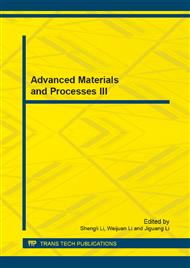p.262
p.266
p.273
p.279
p.284
p.289
p.293
p.297
p.302
Effects of Aging Precipitates on the Mechanical and Corrosion Resistance Properties of 18Cr-18Mn-2Mo-0.96N Super High Nitrogen Austenitic Stainless Steel
Abstract:
This paper investigates the effects of aging precipitates on the mechanical and corrosion resistance properties of 18Cr-18Mn-2Mo-0.96N super high nitrogen austenitic stainless steel (HNS) through Vickers hardness, Charpy impact, tensile and electrical chemical methods. The probable affected mechanism is discussed by optical microscope (OM) and transmission electron microscopy (TEM). The results are presented as follow: the initial TTP curve with 0.05% precipitates volume fraction presents C type which has a nose temperature at 850°C with an incubation period for 60s. The precipitates increase with prolonging aging time to 40%. The HV results of aged HNS present firstly decrease then increase, the relevant yield strength firstly increase then decrease with increasing the aging time. Meanwhile, the impact energy, ultimate tensile strength and elongation are deteriorated significantly because of the formation and growth of cellular Cr2N and χ phase with concomitant increased amount of intergranular Cr2N. The IGC susceptibility increases and the pitting corrosion potentials decrease because of the Cr, N and Mo depletion through the formation of intergranular, cellular Cr2N and intermetallic χ precipitates by aging treatments.
Info:
Periodical:
Pages:
284-288
Citation:
Online since:
September 2013
Authors:
Price:
Сopyright:
© 2013 Trans Tech Publications Ltd. All Rights Reserved
Share:
Citation:


